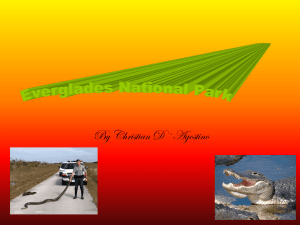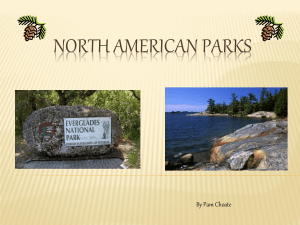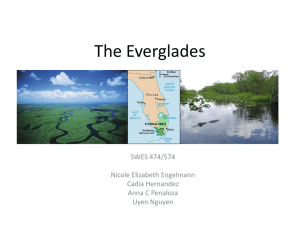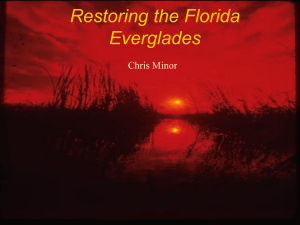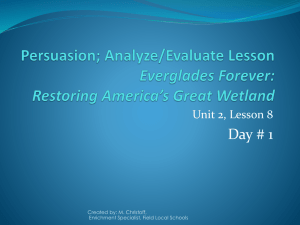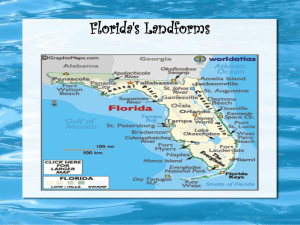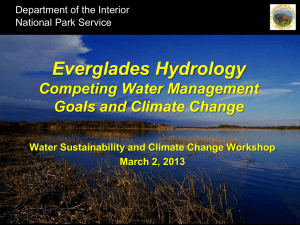project2MASTER - Florida State University
advertisement
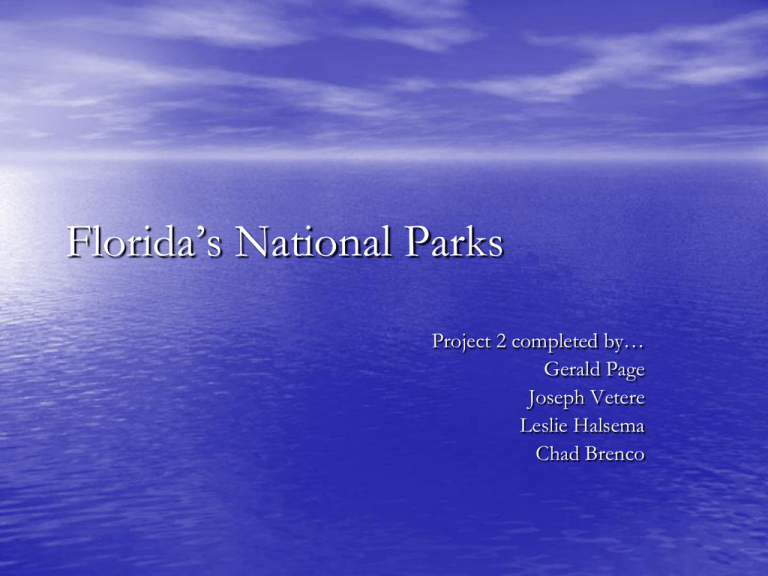
Florida’s National Parks Project 2 completed by… Gerald Page Joseph Vetere Leslie Halsema Chad Brenco National Parks • Yellowstone National Park was established by congress as the first National Park in 1872. • In 1916 the National Park Service was created. • Funded by the Department of the Interior Image of Yellowstone National Park http://farm4.static.flickr.com/3206/2957792033_ff1c9788d 9.jpg The National Park Service covers national parks, monuments, preserves, seashores, recreation areas, historic sites, military parks, battlefields, and other designated areas. What qualifies as a National Park? Generally large natural areas having a wide variety of features, typically including significant historic value. Hunting, mining, and/or any activities that “consume” park resources are not authorized in national parks. The main difference between a national park and a national preserve is that in a preserve you can hunt, fish, etc. The NPS Arrowhead •Authorized as the agency's official emblem by the Secretary of the Interior on July 20, 1951. •The symbol first appeared on a road sign and then a ranger uniform in September 1952. •Registered as an official emblem of the National Park Service on February 9, 1965 by the United States Patent Office. • Its shape and earth-brown background represent historical and archaeological values. • The bison and sequoia tree symbolize the diverse world of plants and animals within the parks system. The bison and sequoia tree were selected because they are symbols from the first two National Parks, Yellowstone and Sequoia. • The mountains and water represent scenic and recreational values. Florida’s National Parks Nort h •There are 3 national parks in Florida: Dry Tortugas National Park, Everglades National Park, and Biscayne National Park. •http://fcit.usf.edu/FLORIDA/maps/1900/63300.htm • Dry Tortugas: the first National Park in Florida – established January 4, 1935 – covers 64,657 acres – 99% of park is open water and submerged islands • Everglades: largest national park in Florida – established December 6, 1947 – covers 1,508,537.9 acres – the largest tract of wilderness east of the Rocky Mountains • Biscayne National Park: – established October 18, 1968 – covers 172,924.07 acres, including two-thirds of Biscayne Bay Biscayne National Park – A Watery Wonderland – Location – Ecology – Things to Do – Issues Biscayne National Park - Location • Enjoy a view of downtown Miami and pristine marine life when you visit • Covers ~200 square miles (172,971 acres ) • MAP IT HERE! • Northern most island of the FL Keys Biscayne National Park - Ecology • Home to several unique and very diverse ecosystems like Mangroves, Coral Reefs & Pristine Beaches (and close • proximity to a great social scene…) Each ecosystems is comprised of a variety of smaller communities like seagrass meadows, hardbottom areas and hardwood hammocks. The geology of the area has been influenced by changing sea levels, currents, hurricanes, and reef-building organisms like corals. South Florida's subtropical climate produces forest types that are more typical of the Caribbean than of mainland North America. Biscayne National Park - Ecology • Mangrove = several trees • Protects the shoreline from erosion – Important protection from hurricane winds • Safe haven for small animals (craps, fish) • Impenetrable root system to help to keep Biscayne's waters clean and clear by slowing the water that flows into the bay from the land, allowing the sediment carried by the runoff to disperse Biscayne National Park - Ecology • Coral Reefs are most diverse • • • • ecosystems Home to over 200 species of fish The coral reefs are a community of many different types of marine organisms Polyps (fan-like) obtain calcium and form structure of reef Other marine life to see: loggerhead sea turtles, nurse sharks, moray, dolphins Biscayne National Park - Ecology • The Bay & Beaches are unique as well • Biscayne Bay is a shallow estuary, where freshwater from the land mixes with salt water from the sea and marine life Biscayne National Park – Things to do… • SCUBA! Tons of undersea life • Relax on sandy beaches! • Camping • Canoeing/Kayaking • Fishing & Lobstering • Did you know? One of South Florida’s best windsurfing location Biscayne National Park - Issues • Local hydrology (runoff, pollution) • Improper mixing of salt/fresh water • Non-native species (Brazilian Pepper, Australian Pine, Cuban tree frog) • City noise is a big problem Dry Tortugas History and Composition • Discovered in 1513 by • • Juan Ponce de Leon. Composed of seven islands made from coral reef remains, sand and limestone. The park is 100 mi2 in which 46 mi2 is a Research Natural Area. http://ocean.floridamarine.org/mrgi s_ims/Description_Layers_Marine.ht m Dry Tortugas Wildlife • Several important game- fish can be found in the Dry Tortugas, including Snappers, Groupers and Grunts. Fish that spawn in the Tortugas can be carried away by oceanic currents and have been traced as far as Tampa Bay and Cape Canaveral. http://www.eurekalert.org/multimedia/pub/88 00.php?from=116914 Dry Tortugas Wildlife (cntd.) • Several Bird Species make the Dry Tortugas their home, including Sooty Terns, Noddy Terns, and the Masked Booby. The Terns lay their eggs and raise their young from February to September. http://www.msstate.edu/org/mos/Images/Soot y%20Tern%201.jpg Dry Tortugas Wildlife (cntd.) • Loggerhead and Green Sea Turtles use the beaches of the islands to lay their eggs. The lack of lights on the islands help prevent the baby Sea Turtles from being killed. http://zoltantakacs.com/zt/pw/re/album.php?i dx=7 Dry Tortugas Issues • Tourism! According to the South Florida Natural Resource Center, the park witnessed an increase in visitation between 1994 and 2000 which increases the risk of invasive species, anchor damage and water degradation. http://www.nps.gov/drto/photosmultimedia/ind ex.htm?eid=147603&root_aId=235#e_147603 Dry Tortugas Issues (cntd.) • A major problem throughout the park and the region is over-fishing. According to the South Florida Natural Resources Center, the use of fish finders has made fishing easier and faster. http://www.greenpeace.org/raw/image_full/m editerranean/photosvideos/photos/overfishingin-the-mediterrane.jpg Dry Tortugas Issues (contd.) • However, the Dry Tortugas Research Expedition led by Dr. Jerald Ault of the University of Miami found that within RNA zones, populations of Grouper, Snapper and other fish were increasing. http://www.nps.gov/drto/parkmgmt/upload/D RTO%20RNA%20Map%20final%203-8-07.jpg Everglades National Park Everglades National Park • Largest subtropical wilderness in the United States • Boasts rare and endangered species. • It has been designated a World Heritage Site, International Biosphere Reserve, and Wetland of International Importance, significant to all people of the world. Animals of the Everglades • Since its dedication in 1947, Everglades National Park has been called one of the great biologic wonders of the world. • This expansive thriving wetland encompasses the tiniest grass frog to the biggest American crocodile. • This wide range of life includes species from the Caribbean tropics and more familiar species from the temperate North America. Birds in the Everglades • Over 360 species • have been recorded in the park and the list continues to grow. The Everglades remain one of the best destinations for easily observing great concentrations of many diverse bird species. Fish in the Everglades • Nearly 300 different • species of fish are known to inhabit the freshwater marshes and marine coastline of Everglades National Park. Fishing remains one of the most popular activities in the park. Mammals and Reptiles in the Everglades • Over 40 species of • • mammals are found in Everglades National Park. Over 50 distinct kinds of reptiles can be found in the park. Many species commonly associated with drier habitats of forest and fields have adapted to the semi-aquatic environment that comprise most of the park's acreage. Plants in the Everglades • The Everglades serve as • important habitat for a number of both endemic and legally protected species found here. Non-native plants are one of the greatest threats to the natural ecosystems of the United States and are destroying America's natural history and identity. This includes the Everglades. Threats to the Everglades • Water Control • Introduced Species • Development Water Control • Water control has been • achieved through the use of drainage canals and pumping stations throughout the Everglades region Currently there are over 1,400 miles (2,253 kilometers) of canals and levees within the Everglades region used for water control and diversion. A water control structure used for water discharge Water Data Collection Station Invasive Bastards • Australian Pine • (Casuarina equisetifolia) This fast growing pine displaces native beach dune vegetation by altering light, temperature, and soil chemistry through the formation of a thick blanket of fallen leaves and fruit. Invasive Bastards • Brazilian Pepper (Schinus terebinthifolius) • This aggressive plant is • considered one of the most invasive in Florida. It produces a chemical which can suppress the growth of other plants and irritate human skin. Invasive Bastards • Juvenile Mayan • Cichlid An introduced species found in the freshwater marshes of the Everglades Development • Development pressures • from agriculture, industry, and urban areas have destroyed more than half of the original Everglades Agriculture, such as sugar cane, rice, and dairy farms, exists on drained land within the Everglades. Visit the Everglades! • There are many different experiences that a • • • visitor can have at Everglades National Park. Camping, boating, hiking, and even a visit to a former missile base in the center of the park are all possible. Many have enjoyed exploring some of the 156 miles (251 km) of canoe/kayak and walking trails and 47 designated wilderness campsites opportunities for solitude. Current schedules and information can be found at www.nps.gov.
